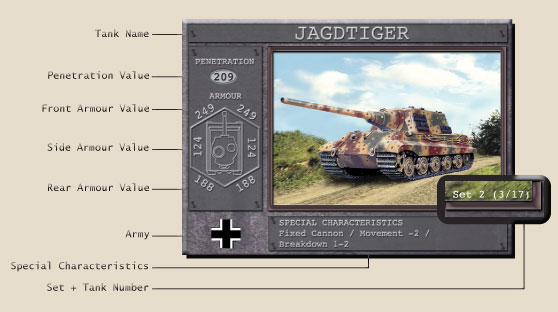Each tank has an associated game card made up of 2 sides. One side gives the history and technical specifications of the tank; the other side provides information necessary to play Panzer Squadron. HISTORY & TECHNICAL DATA
This information is principally aimed at collectors and provides a mine of information about the world of the tank in question: Its origins, history and camouflage. It also provides technical specifications: the size of the crew, weight, length, width, inception date and the calibre of its gun.
GAME DATA

Penetration Value
During the resolution of combat situations this value gives the basis on which to determine if one tank has managed to pierce the armour of the opposing tank. This value will be modified during combat resolution by factors based both on the game state and on chance.
Armour Value
This value represents the armour of your tank. You will need the value for Front, Side or Rear armour depending on the position of the tank firing on yours. (See Armour Diagram p.8).
Special Characteristics
These are tank-specific characteristics which have an influence on how the game is played.
Breakdown "X"
During your turn, the first time you activate a tank with the characteristic "Breakdown", roll a 6 sided dice. If you roll a number equal to "X", that tank cannot move for that turn, though it can still turn its turret and fire on opponent's tanks.
Movement Restrictions
Certain tanks are extremely slow, heavy or have difficulties in negotiating uneven terrain. These tanks will be marked with "Movement -X" to define their particular restrictions. Subtract the "-X" bonus from your total when you roll a movement dice.
Fixed Cannon
Certain tanks don't have rotating turrets. These are fixed cannons that require the tank itself to be turned and thus gave a disadvantage when positioning the tank to fire as each change in position requires you to spend a point of movement.
Firing Restrictions
Certain tanks were less accurate than other tanks. This is reflected in a firing restriction of "Shot -X" in the Special Characteristics box. Subtract the "-X" bonus from your total when you roll a shot D10 dice.
|